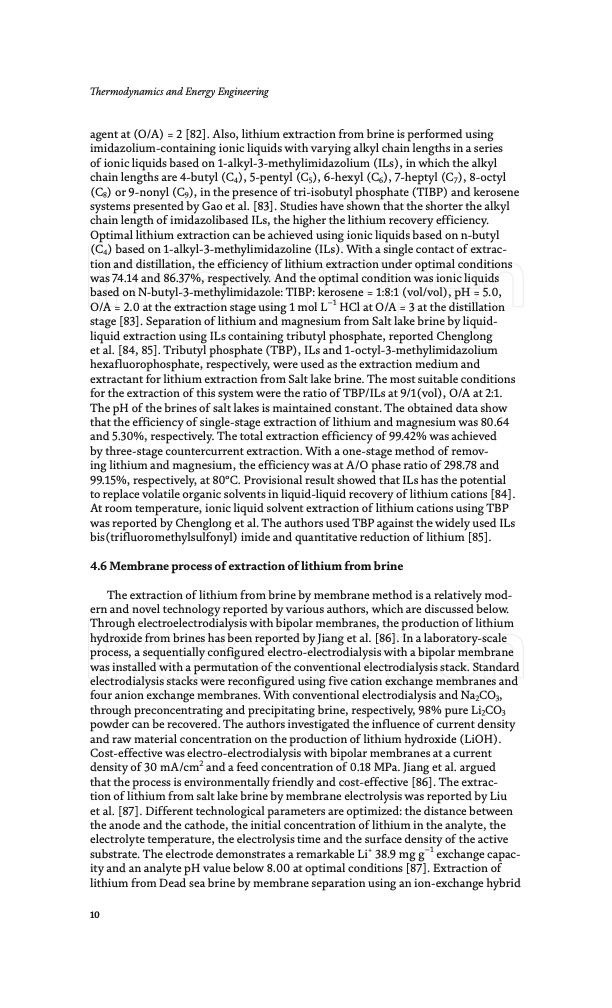
PDF Publication Title:
Text from PDF Page: 012
Thermodynamics and Energy Engineering agent at (O/A) = 2 [82]. Also, lithium extraction from brine is performed using imidazolium-containing ionic liquids with varying alkyl chain lengths in a series of ionic liquids based on 1-alkyl-3-methylimidazolium (ILs), in which the alkyl chain lengths are 4-butyl (C4), 5-pentyl (C5), 6-hexyl (C6), 7-heptyl (C7), 8-octyl (C8) or 9-nonyl (C9), in the presence of tri-isobutyl phosphate (TIBP) and kerosene systems presented by Gao et al. [83]. Studies have shown that the shorter the alkyl chain length of imidazolibased ILs, the higher the lithium recovery efficiency. Optimal lithium extraction can be achieved using ionic liquids based on n-butyl (C4) based on 1-alkyl-3-methylimidazoline (ILs). With a single contact of extrac- tion and distillation, the efficiency of lithium extraction under optimal conditions was 74.14 and 86.37%, respectively. And the optimal condition was ionic liquids based on N-butyl-3-methylimidazole: TIBP: kerosene = 1:8:1 (vol/vol), pH = 5.0, O/A = 2.0 at the extraction stage using 1 mol L−1 HCl at O/A = 3 at the distillation stage [83]. Separation of lithium and magnesium from Salt lake brine by liquid- liquid extraction using ILs containing tributyl phosphate, reported Chenglong et al. [84, 85]. Tributyl phosphate (TBP), ILs and 1-octyl-3-methylimidazolium hexafluorophosphate, respectively, were used as the extraction medium and extractant for lithium extraction from Salt lake brine. The most suitable conditions for the extraction of this system were the ratio of TBP/ILs at 9/1(vol), O/A at 2:1. The pH of the brines of salt lakes is maintained constant. The obtained data show that the efficiency of single-stage extraction of lithium and magnesium was 80.64 and 5.30%, respectively. The total extraction efficiency of 99.42% was achieved by three-stage countercurrent extraction. With a one-stage method of remov- ing lithium and magnesium, the efficiency was at A/O phase ratio of 298.78 and 99.15%, respectively, at 80°C. Provisional result showed that ILs has the potential to replace volatile organic solvents in liquid-liquid recovery of lithium cations [84]. At room temperature, ionic liquid solvent extraction of lithium cations using TBP was reported by Chenglong et al. The authors used TBP against the widely used ILs bis(trifluoromethylsulfonyl) imide and quantitative reduction of lithium [85]. 4.6 Membrane process of extraction of lithium from brine The extraction of lithium from brine by membrane method is a relatively mod- ern and novel technology reported by various authors, which are discussed below. Through electroelectrodialysis with bipolar membranes, the production of lithium hydroxide from brines has been reported by Jiang et al. [86]. In a laboratory-scale process, a sequentially configured electro-electrodialysis with a bipolar membrane was installed with a permutation of the conventional electrodialysis stack. Standard electrodialysis stacks were reconfigured using five cation exchange membranes and four anion exchange membranes. With conventional electrodialysis and Na2CO3, through preconcentrating and precipitating brine, respectively, 98% pure Li2CO3 powder can be recovered. The authors investigated the influence of current density and raw material concentration on the production of lithium hydroxide (LiOH). Cost-effective was electro-electrodialysis with bipolar membranes at a current density of 30 mA/cm2 and a feed concentration of 0.18 MPa. Jiang et al. argued that the process is environmentally friendly and cost-effective [86]. The extrac- tion of lithium from salt lake brine by membrane electrolysis was reported by Liu et al. [87]. Different technological parameters are optimized: the distance between the anode and the cathode, the initial concentration of lithium in the analyte, the electrolyte temperature, the electrolysis time and the surface density of the active substrate. The electrode demonstrates a remarkable Li+ 38.9 mg g−1 exchange capac- ity and an analyte pH value below 8.00 at optimal conditions [87]. Extraction of lithium from Dead sea brine by membrane separation using an ion-exchange hybrid 10PDF Image | Lithium Recovery from Seawater Salt Lake Brine

PDF Search Title:
Lithium Recovery from Seawater Salt Lake BrineOriginal File Name Searched:
IntechOpenSamadiyBookchapter.pdfDIY PDF Search: Google It | Yahoo | Bing
Product and Development Focus for Infinity Turbine
ORC Waste Heat Turbine and ORC System Build Plans: All turbine plans are $10,000 each. This allows you to build a system and then consider licensing for production after you have completed and tested a unit.Redox Flow Battery Technology: With the advent of the new USA tax credits for producing and selling batteries ($35/kW) we are focussing on a simple flow battery using shipping containers as the modular electrolyte storage units with tax credits up to $140,000 per system. Our main focus is on the salt battery. This battery can be used for both thermal and electrical storage applications. We call it the Cogeneration Battery or Cogen Battery. One project is converting salt (brine) based water conditioners to simultaneously produce power. In addition, there are many opportunities to extract Lithium from brine (salt lakes, groundwater, and producer water).Salt water or brine are huge sources for lithium. Most of the worlds lithium is acquired from a brine source. It's even in seawater in a low concentration. Brine is also a byproduct of huge powerplants, which can now use that as an electrolyte and a huge flow battery (which allows storage at the source).We welcome any business and equipment inquiries, as well as licensing our turbines for manufacturing.| CONTACT TEL: 608-238-6001 Email: greg@infinityturbine.com | RSS | AMP |